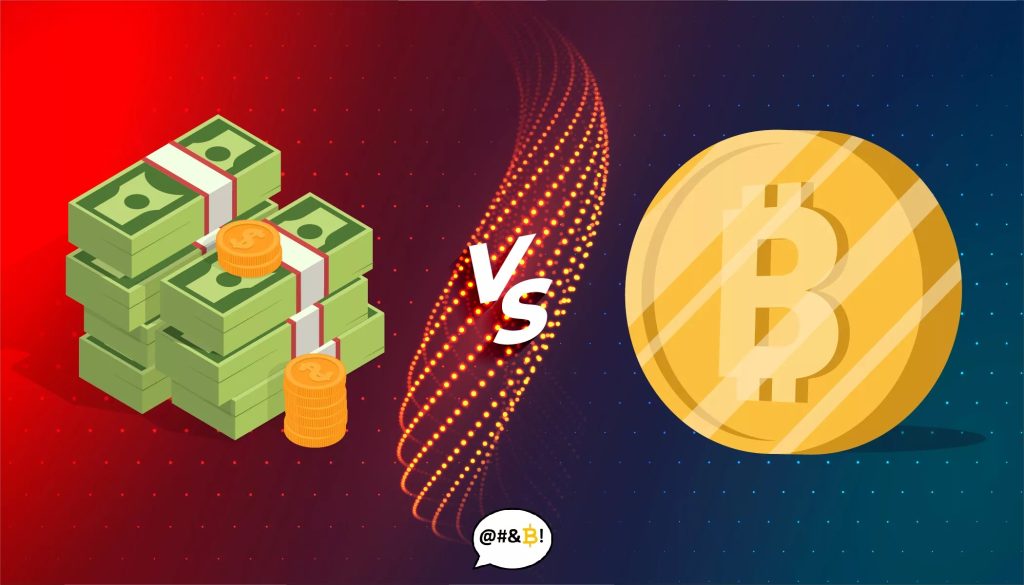Unlike traditional investments or currencies, Bitcoin is unique in its technology, economics, and social dynamics that set its value. Developed in 2009 by the mysterious figure (or group) known as Satoshi Nakamoto, Bitcoin is the first cryptocurrency, creating a blueprint for others to follow. So let’s answer the question, “what gives Bitcoin value?”.
What Determines the Value of FIAT Currencies vs Cryptocurrencies
Let’s start with understanding the basic differences between fiat currencies and cryptocurrencies, in their basic nature and in what determines their value.
Basic Differences
U.S. dollar or the Euro are traditional FIAT currencies issued by governments. They hold value because governments declare them as legal tender and they are available to pay for goods and services. Central authorities, such as central banks, manage their supply and influence their value through monetary policies regulates them.
Cryptocurrencies, on the other hand, only exist in digital form and they use cryptography for security. They use blockchain technology that makes them decentralized. This means that no single entity, like a government or bank, has control over them. Prominent examples include Bitcoin and Ethereum.
Value Determination
Fiat currencies’ value is effected by factors like government policies, inflation rates, economic growth, and geopolitical stability, and central banks can also adjust the supply of money and set interest rates.

In contrast, the value of cryptocurrencies is determined more by market demand and supply dynamics, technological advancements, regulatory changes, and investor sentiment. For cryptocurrencies like Bitcoin, capped supply (like the 21 million Bitcoin limit) creates a scarcity similar to that of precious commodities like gold.
While fiat currencies are primarily used for daily transactions, cryptocurrencies are popular as an investment asset and as a medium of exchange. They are also known for their price volatility, which can be influenced by factors ranging from technological upgrades to social media trends.
What Gives Bitcoin Value? – Supply & Demand of Bitcoin (BTC) Crypto
Bitcoin’s value depends on its scarcity. Bitcoin’s protocol making sure that there will never be more than 21 million Bitcoins. This limited supply reflects the principles that give value to commodities like gold or silver. Scarcity alone, however, isn’t enough. The demand for Bitcoin plays an equally role. As more people and institutions show interest in owning Bitcoin, its price tends to rise, reflecting the classic economic principle of supply and demand. In 2023 there is about 425 million cryptocurrency users worldwide. This is just around 4.2% of the global population.
Decentralization and the Technology
Bitcoin’s decentralized nature adds a layer of value. Decentralization is possible by blockchain technology, that records all Bitcoin transactions in a secure and transparent manner. That means there is a public ledger consists of connected blocks of transaction information. This ledger is immutable, this is why it’s so reliable. This technology supports Bitcoin as a digital currency but also reinforces its role as a digital asset, free from manipulation by any single entity.
Bitcoin as a Commodity and Currency
Bitcoin is both a commodity and a currency supports its value. Like gold, many view Bitcoin as a store of value – an investment that potentially grow in value over time. Also as it is usable as a medium of exchange positions Bitcoin as a useful financial instrument.

The Influence of Volatility and Market Sentiments
It’s important to acknowledge Bitcoin’s price volatility. Regulatory changes, technological advancements, and shifts in investor sentiment can cause rapid price fluctuations. This volatility, while a source of risk, also presents opportunities for significant returns, attracting a diverse range of investors to the cryptocurrency.
The Impact of Bitcoin Mining on Its Value – Scarcity
The mining process involves solving complex cryptographic puzzles, requiring significant computational power and energy. The miners, in return, are rewarded with new Bitcoins. This process means that new Bitcoins added to the circulation and secures the blockchain network.
Its cost, which includes the expenses for high-powered computers, electricity, and maintenance, impacts its market price. Higher production costs occur a higher valuation of Bitcoin, as miners seek to maintain profitability. Additionally, the Bitcoin protocol adjusts the difficulty of mining tasks, making sure that new Bitcoins are produced at a predictable rate, further influencing the supply dynamics.
Supply Constraints and Halving Events
Bitcoin’s programming includes a unique feature called ‘halving’. It happens approximately every four years, when the reward for mining a new block is halved. This mechanism slows down Bitcoin creation’s rate, reinforcing its scarcity. The most recent halving occurred in 2020, and each event has historically been a catalyst for significant fluctuations in Bitcoin’s value.
Competition and Regulation
While Bitcoin is the most known cryptocurrency, alternatives (altcoins) like Ethereum, BNB, and Solana has introduced new dynamics to the crypto market. These altcoins have attracted investor attention, impacting Bitcoin’s dominance in the market. However, this competition has also played a role in increasing overall awareness and adoption of cryptocurrencies, indirectly benefiting Bitcoin. For example in 2017 Bitcoin covered 80% of the overall crypto market capitalization and in 2023 it has dropped below 50%.
The Influence of Regulatory Measures
Regulatory decisions around the world also impact Bitcoin’s value. For example, announcements of regulations or bans in major markets like the U.S. or China. Conversely, positive regulatory news, such as the approval of Bitcoin ETFs (in the US the Securities and Exchange Commission – SEC rules it), tends to boost investor confidence. As governments and financial authorities continue to consider how to regulate cryptocurrencies, these regulatory developments will remain a key factor in Bitcoin’s price. For example just some weeks after the SEC accepted the first Bitcoin ETF BTC’s price reached its highest ever at over $68,000 in October 2021. However at the beginning of 2022 it dropped back to around $41,000.
Bitcoin’s Relationship with Media and Public Perception
The media shapes public perception of Bitcoin, and consequently, its value. Positive news coverage can lead to increased interest and demand, pushing up prices. Conversely, negative reports, especially concerning security, regulatory issues, or market manipulations, can lead to declines in value. The influence of high-profile individuals and investors, often reinforced by social media, can also affect market confidence, leading to quick price movements.
Conclusion
The combination of production costs, demand, competition, regulatory developments, and the media coverage collectively shapes investor perceptions. This investor outlook is a key element impacting the pricing of cryptocurrencies.




